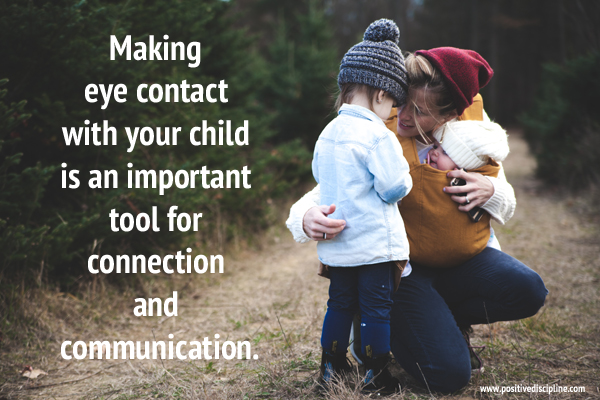Excerpt from Positive Discipline for Preschoolers
by Dr. Jane Nelsen, Cheryl Erwin, and Roslyn Ann Duffy
Adults and children express emotional energy on their faces, in their voices, and in the way they move or stand. Because children are still developing their language skills, they trust the message of this nonverbal communication far more than they do mere words.
Three‐year‐old Kyle scampers into the kitchen where Linda, his mother, late for a meeting, is preparing dinner.
“Look, Mommy, look—I drew an airplane!” Kyle bubbles, waving his paper excitedly.
“That’s great, sweetie. You’re quite an artist,” his harried mother replies without glancing up.
Linda undoubtedly means well, and there is certainly nothing wrong with her words, but Kyle notices that her hands never stop grating cheese for the casserole and her eyes never quite look at his airplane. What message has Kyle really received?
Five‐year‐old Wendy is helping her dad make lunch. Wendy’s little brother is cranky, and Dad is trying to watch the football game on television while he makes the grilled cheese sandwiches. Wendy is valiantly pouring milk when the heavy carton slips from her grasp, sending a half-gallon of foamy liquid across the kitchen floor.
Wendy looks up timidly into her father’s face. “I’m sorry, Daddy,” she says. “Are you mad?”
Dad’s eyebrows lower ominously, his jaw tightens, and when he speaks his voice is thin and tense. “No, I’m not mad,” he says. When Wendy bursts into tears, he wonders why.
Ms. Santos is reading a nap-time story to her class of four‐year‐olds. She hasn’t had a break because her replacement didn’t show up and no substitute teacher is available.
Little Allie looks at her teacher and asks, “Don’t you like this story?”
Ms. Santos looks at Allie in surprise and answers, “Of course I do. Why?”
Allie answers, “Because your face is all scrunched up.”
Eye to Eye
As your child grows and develops, you need to be constantly aware of the messages you are sending him or her—and whether your words and your actions agree. Children notice what we do, even more than what we say. For instance, saying “I love you” may, not be the most effective way to communicate that message to your child. Saying the words often (and meaning them) is important, but words alone won’t communicate this vital message to your young child.
Imagine how powerful it will feel if you kneel in front of her, look her directly in the eye, smile, and in your warmest tone of voice say, “I love you.” Now the words and nonverbal cues match up—and a big hug may be on the way! Nonverbal communication teaches children about connection, feelings, and, eventually, the words that go with them.

Making eye contact with your child is an important tool for connection and communication. If you want to communicate, get down on the child’s level. Kneel next to him, sit beside him on the sofa, or (as long as you hold on to him) set him on a counter where his eyes can meet yours comfortably. Now, not only can you maintain eye contact while you speak to him, but you’ve eliminated the sometimes overpowering difference in size and height. Also, watch out for the signals your posture sends: crossed arms or legs, for example, can indicate resistance or hostility. Your child will be quick to notice.
Susan was standing over her daughter, Michele trying to coax her into sharing what was upsetting her. “Come on, honey,” Susan said gently, “I really want to help.”
Michele hesitated, then said, “But you might get mad at me.”
Susan smiled encouragingly and replied, “Michele, I promise I won’t get mad. I care about you, and I want you to be able to tell me anything.”
Michele thought for a moment, then looked up into her mother’s face. “I don’t want to. I’m scared!”
Poor Susan—she was trying hard to be unconditionally accepting and loving. Her daughter, however, was intimidated by her mother standing over her. If Susan gets down on her daughters level, her words and her expression match consistently, Michele will feel more comfortable talking openly with her mother.
Tone of Voice
Your tone of voice may be the most powerful nonverbal tool of all. Try saying a simple sentence, such as “I can’t help you,” emphasizing a different word each time. How does the meaning change? Even inoffensive phrases like “Have a nice day” can become poisonous if you choose a particularly cold tone of voice. It is often the way you say something, rather than the words you use, that carries the message. Remember, children are especially sensitive to the nuances of nonverbal communications.
Facial Expressions and Touch
When you’re feeling particularly blue, does it help when a friend smiles and gives you a pat on the shoulder or a friendly hug? The way you look at your child and the way you use your hands can communicate very effectively without a single word being spoken.
Tommy is curled up on the couch under a blanket, suffering from a bad case of the flu. Dad walks by, adjusts the blanket, and gently ruffles Tommy’s hair. Has anything been communicated? Chances are Tommy knows without words that his dad cares about him, wants to help, and hopes he’ll soon feel better.
Remember that the feeling behind what you do or say is more important than what you do or say.

